Unit 3 Sea Exploration Reading and Thinking 课件(共26张PPT)-2025-2026学年人教版(2019)选择性必修第四册
文档属性
| 名称 | Unit 3 Sea Exploration Reading and Thinking 课件(共26张PPT)-2025-2026学年人教版(2019)选择性必修第四册 | 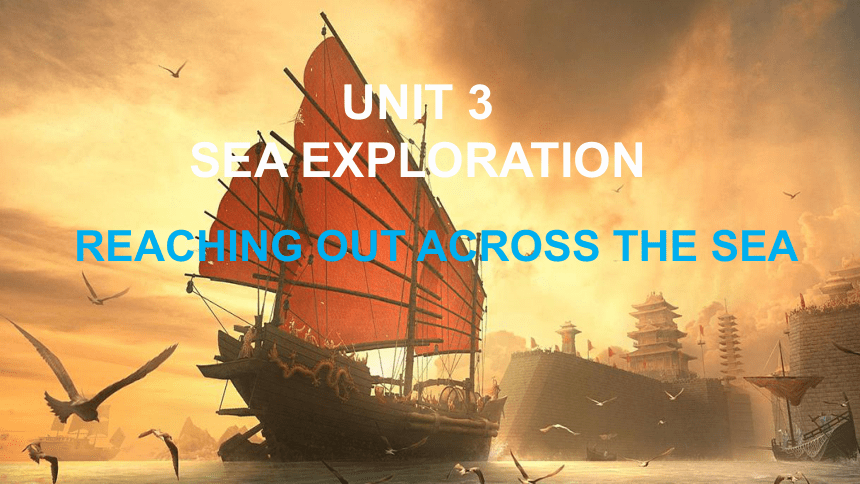 | |
| 格式 | pptx | ||
| 文件大小 | 13.3MB | ||
| 资源类型 | 教案 | ||
| 版本资源 | 人教版(2019) | ||
| 科目 | 英语 | ||
| 更新时间 | 2025-06-13 12:22:31 | ||
图片预览

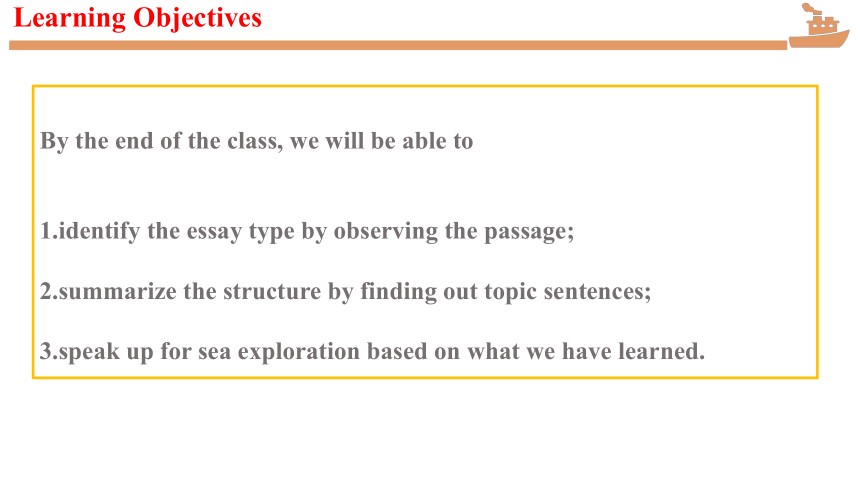
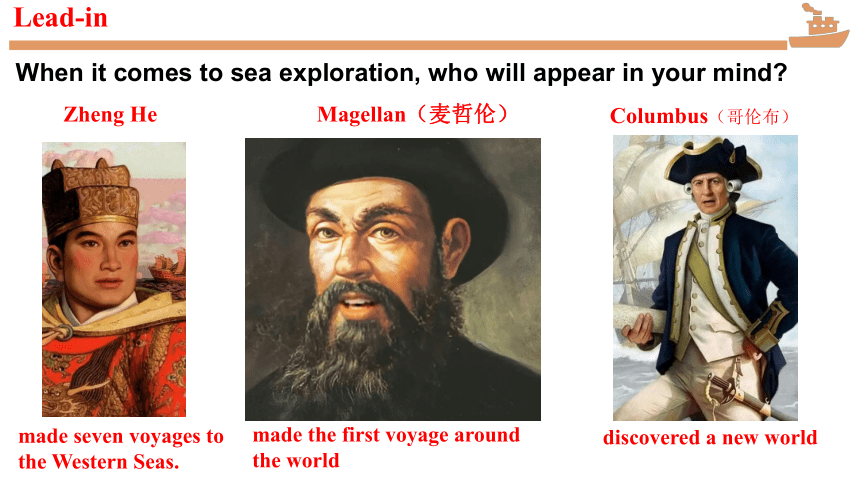
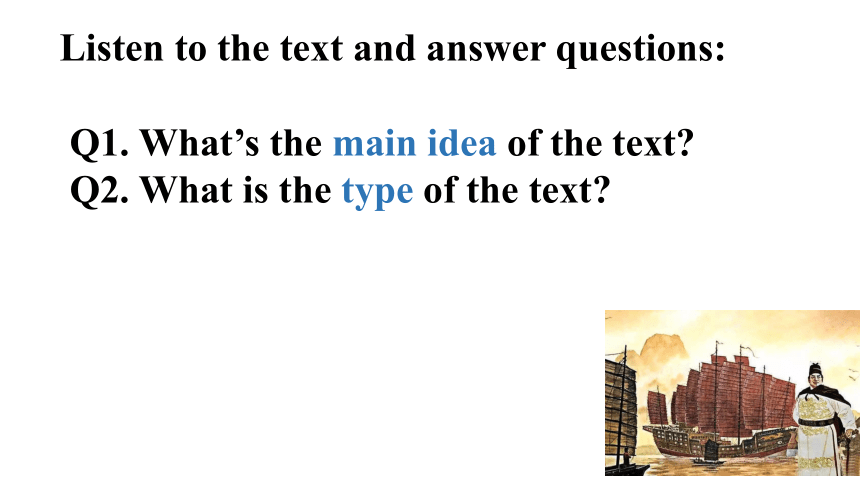
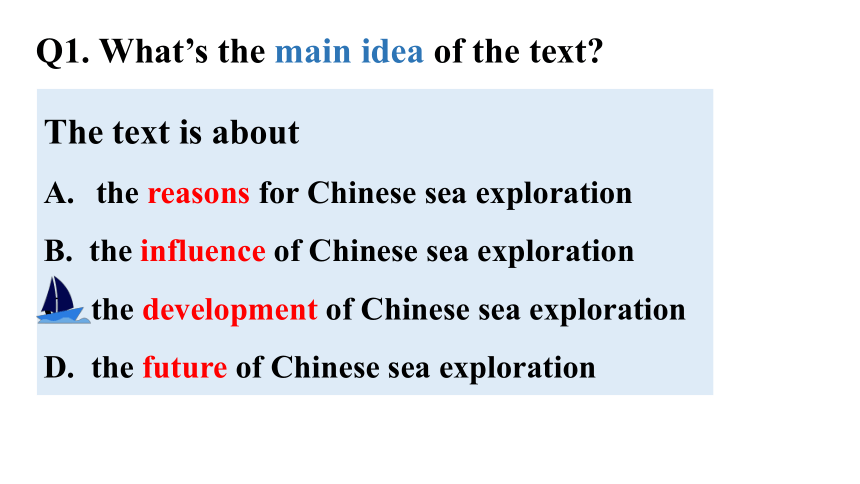
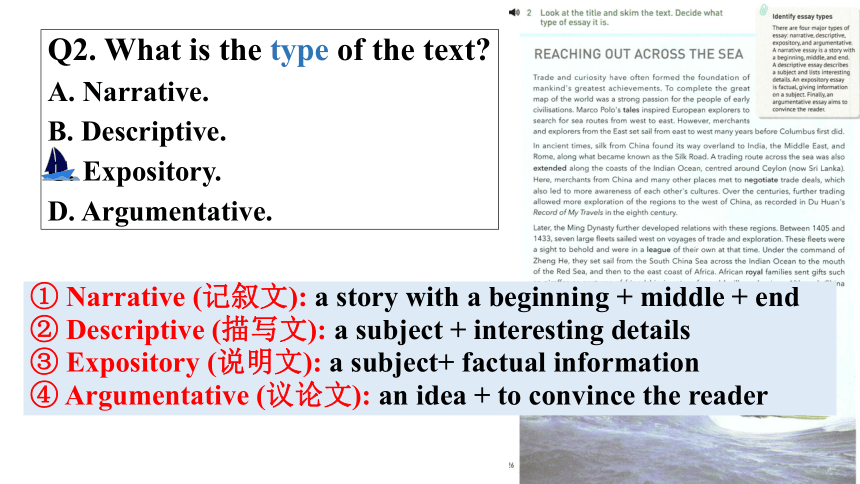

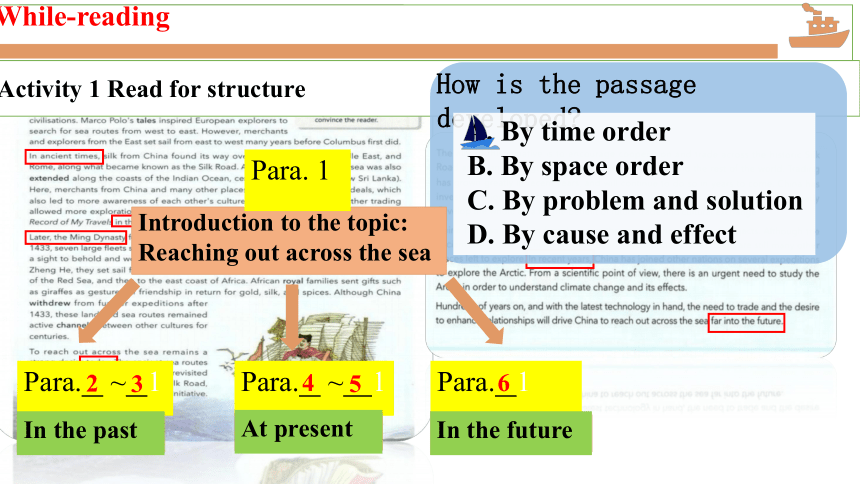
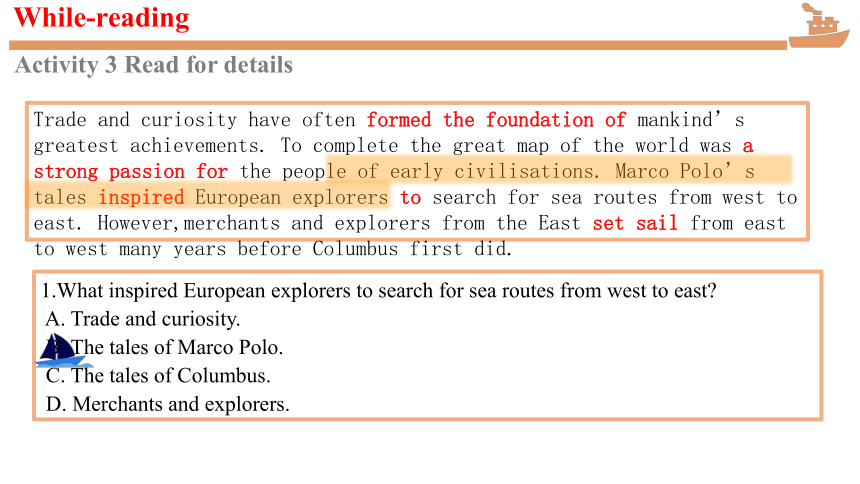
文档简介
(共26张PPT)
UNIT 3
SEA EXPLORATION
REACHING OUT ACROSS THE SEA
By the end of the class, we will be able to
1.identify the essay type by observing the passage;
2.summarize the structure by finding out topic sentences;
3.speak up for sea exploration based on what we have learned.
Learning Objectives
When it comes to sea exploration, who will appear in your mind
Lead-in
Columbus(哥伦布)
discovered a new world
made seven voyages to
the Western Seas.
Zheng He
made the first voyage around the world
Magellan(麦哲伦)
Listen to the text and answer questions:
Q1. What’s the main idea of the text
Q2. What is the type of the text
Q1. What’s the main idea of the text
The text is about
the reasons for Chinese sea exploration
B. the influence of Chinese sea exploration
C. the development of Chinese sea exploration
D. the future of Chinese sea exploration
Prediction
Q2. What is the type of the text
A. Narrative.
B. Descriptive.
C. Expository.
D. Argumentative.
① Narrative (记叙文): a story with a beginning + middle + end
② Descriptive (描写文): a subject + interesting details
③ Expository (说明文): a subject+ factual information
④ Argumentative (议论文): an idea + to convince the reader
Para.1 A. China will be driven to reach out across the sea far into
the future.
Para.2 B. Travel from east to west began long before Columbus.
Para.3 C. In ancient times, travel from east to west was on the Silk
Road.
Para.4 D. Ming Dynasty ’s expansion of relations through maritime
expedition led by Zheng He.
Para.5 E. The 21st Century Maritime Silk Road.
Para.6 F. China is also joining with other countries on other
important projects.
While-reading
Activity 1 Read for main idea
TIP: the first or last sentence or after the transitional words
How is the passage developed
While-reading
Activity 1 Read for structure
How is the passage developed
A. By time order
B. By space order
C. By problem and solution
D. By cause and effect
Para. ~ 1
Para. ~ 1
Para. 1
In the past
At present
Introduction to the topic: Reaching out across the sea
In the future
Para. 1
2
3
4
5
6
Trade and curiosity have often formed the foundation of mankind’s greatest achievements. To complete the great map of the world was a strong passion for the people of early civilisations. Marco Polo’s tales inspired European explorers to search for sea routes from west to east. However,merchants and explorers from the East set sail from east to west many years before Columbus first did.
Activity 3 Read for details
While-reading
1.What inspired European explorers to search for sea routes from west to east
A. Trade and curiosity.
B. The tales of Marco Polo.
C. The tales of Columbus.
D. Merchants and explorers.
Trade and curiosity have often formed the foundation of mankind’s greatest achievements. To complete the great map of the world was a strong passion for the people of early civilisations. Marco Polo’s tales inspired European explorers to search for sea routes from west to east.However,merchants and explorers from the East set sail from east to westmany years before Columbus first did.
Activity 3 Read for details
While-reading
2.Why did merchants and explorers try to explore the seas across the world
A. Because they liked to do it.
B. Because they were forced to do it.
C. Because they needed to complete the world map.
D. Because they were inspired by Marco Polo.
Activity 3 Read for details
While-reading
in ancient times
in the Ming Dynasty
today
in recent years
far into the future
Time
Place
Purpose
Para. 2
Para. 3
Para. 4
Para. 5
Para. 6
In ancient times,silk from China found its way overland to India,the Middle East,and Rome,along what became known as the Silk Road. A trading route across these a was also extended along the coasts of the Indian Ocean,centered around Ceylon(now Sri Lanka). Here,merchants from China and many other places met to negotiate trade deals,which also led to more awareness of each other’s cultures. Over the centuries,further trading allowed more exploration of the regions to the west of China,as recorded in Du Huan’s Record of My Travels in the eighth century.
Activity 3 Read for details
While-reading
Later, the Ming Dynasty further developed relations with these regions. Between 1405 and 1433,seven large fleets sailed west on voyages of trade and exploration. These fleets were a sight to behold and were in a league of their own at that time. Under the command of Zheng He, they set sail from the South China Sea across the Indian Ocean to the mouth of the Red Sea, and then to the east coast of Africa. African royal families sent gifts such as giraffes as gestures of friendship in return for gold, silk, and spices. Although China withdrew from further expeditions after1433, these land and sea routes remained active channels between other cultures for centuries.
Activity 3 Read for details
While-reading
2.What's the author's attitude towards Zheng He
A. Critical. B. Supportive.
C. Indifferent. D. Doubtful.
To reach out across the sea remains a strong desire today. The ancient sea routes travelled by Zheng He are being revisited with the 21st Century Maritime Silk Road,which is part of the Belt and Road Initiative. The aim of this initiative is to encourage cooperation and trade across the historic Silk Road areas, and strengthen the bonds between China and the rest of the world. Trading has grown greatly in recent years, and will continue to do so in years to come. China has invested billions in systems and services along these routes, which will help to greatly develop the whole area for the benefit of future trade and cultural exchange.
Activity 3 Read for details
While-reading
What bonds(纽带) do you think can be strengthened between China and the
rest of the world in the Belt and Road Initiative(一带一路倡议)
Activity 4 Read for further thinking
While-reading
2.What bonds do you think can be strengthened between China and the
rest of the world in the Belt and Road Initiative(一带一路倡议)
Hundreds of years on, and with the latest technology in hand, the need to trade and the desire to enhance relationships will drive China to reach out across the sea far into the future.
Activity 3 Read for details
While-reading
4.What can we infer from the text
A. Columbus' exploration was stopped for economic reasons.
B. No accurate maps of the countries around the Indian Ocean existed before Zheng He.
C. China will have more expeditions across the sea far into the future.
D. The giraffe was an animal that could not be found in China in the Ming Dynasty.
China has also joined its friends across the sea on other important projects. Although the ancient sea routes of Zheng He have been travelled many times, there are still many other places left to explore. In recent years, China has joined other nations on several expeditions to explore the Arctic. From a scientific point of view, there is an urgent need to study the Arctic in order to understand climate change and its effects.
in ancient times
in the Ming Dynasty
today
in recent years
far into the future
Time
Region
Purpose
/ Significance
China, India, the Middle East, Rome, the coasts of the Indian Ocean and Sri Lanka
the South China Sea, the Indian Ocean, the mouth of the Red Sea, the east coast of Africa
1. to ________ trade deals;
2. be more aware of each other’s _________.
to further ________ relations
Para. 2
Para. 5
Para. 4
Para. 3
Para. 6
negotiate
cultures
develop
the ancient sea routes travelled by Zheng He, the Belt and Road Area
1. to encourage __________ and trade;
2. to strengthen the ________;
3. to develop the whole area for the benefit of future trade and _______ _______.
cooperation
bonds
cultural exchange
China, the Arctic
to understand _________
_________and its effects
climate
change
China
to trade
and
________
relationships
enhance
Ⅰ.Read the passage quickly and
then fill in the blanks.
1.Trade and curiosity
2.by land
3.by sea
4.Maritime
5.aim
6.the sea
Ⅱ. The main idea of the passage is about the of China’s exploring the sea.
reason, history and future
Read the passage carefully and choose the best answer.
1.Why did the early explorers search for sea routes
A.To find the sea routes from east to west.
B.To discover the mysteries of the sea.
C.Being driven by curiosity and the need to trade.
D.Being inspired by Marco Polo’s tales.
2.How did ancient China trade with other countries
A.Through the Silk Road and sea routes.
B.Through negotiations with other countries at home.
C.By inviting foreign merchants to China.
D.By overland trading.
答案:C
答案:A
3.How can we describe Zheng He’s voyages at that time
A.Astonishing. B.Disappointing.
C.Frightening. D.Encouraging.
4.What’s the aim of the Belt and Road Initiative
A.To transform the historic Silk Road.
B.To encourage trade and cooperation with other countries.
C.To create a worldwide trading atmosphere.
D.To search for new trading and cultural exchange partners.
答案:A
答案:B
5.What is the function of the first sentence in the 4th paragraph
A.To present the background. B.To introduce the topic.
C.To provide an example. D.To make a transition.
答案:D
Fill in the blanks according to the passage.
In ancient times, China traded its silk overland with India, the Middle East, and Rome, along 1 became known as the Silk Road. Meanwhile, a trading route across the sea 2 (extend) along the coasts of the Indian Ocean, centred around Ceylon (now Sri Lanka). Here, merchants from China and many other places met 3 (negotiate) trade deals, 4 also led to more awareness of each other’s cultures.
Later, the Ming Dynasty 5 (far) developed relations with these regions. Between 1405 and 1433, under the command of Zheng He, seven large fleets sailed west on 6 (voyage) of trade and exploration, 7 (seek) cooperation and friendships between China and other countries.
Today, the Belt and Road Initiative 8 (encourage) cooperation and trade across the 9 (history) Silk Road areas, and strengthens the bonds between China and the rest of the world.
Hundreds of years on, and with 10 latest technology in hand, the need to trade and the desire to enhance relationships will drive China to reach out across the sea far into the future.
what
was extended
to negotiate
which
further
voyages
seeking
encourages
historic
the
Scan the text and fill in the table with the correct names.
Name Description
The name of the trade route between China and the West
Its kings sent gifts such as giraffes to China
An area currently being explored for scientific reasons
A destination of silk and a major European capital
The modern country name for Ceylon
The historical period when China expanded maritime exploration to other regions
The author of Record of My Travels
The commander of the seven fleets
The person who wrote stories that inspired European explorers
the Silk Road
African royal families
the Arctic
Rome
Sri Lanka
the Ming Dynasty
Du Huan
Zheng He
Marco Polo
Discuss: Should we explore the sea Why
Critical Thinking
Post-reading
To negotiate trade.
To raise cultural awareness.
To develop relations between countries.
To encourage cooperation.
To strengthen the bonds.
To do scientific research relating to climate changes and life.
After-reading
1. What benefits can we
get from reaching out across the sea
Post-reading
Activity 2 Critical thinking
2. Through sea exploration, what problems can it cause
The waste of money
Marine Pollution
The death of sea creatures
Ecological destruction
They (oceans) provide a breeding ground for life, connect the world and promote development. —Xi Jinping
海洋孕育了生命、联通了世界、促进了发展。—习近平
UNIT 3
SEA EXPLORATION
REACHING OUT ACROSS THE SEA
By the end of the class, we will be able to
1.identify the essay type by observing the passage;
2.summarize the structure by finding out topic sentences;
3.speak up for sea exploration based on what we have learned.
Learning Objectives
When it comes to sea exploration, who will appear in your mind
Lead-in
Columbus(哥伦布)
discovered a new world
made seven voyages to
the Western Seas.
Zheng He
made the first voyage around the world
Magellan(麦哲伦)
Listen to the text and answer questions:
Q1. What’s the main idea of the text
Q2. What is the type of the text
Q1. What’s the main idea of the text
The text is about
the reasons for Chinese sea exploration
B. the influence of Chinese sea exploration
C. the development of Chinese sea exploration
D. the future of Chinese sea exploration
Prediction
Q2. What is the type of the text
A. Narrative.
B. Descriptive.
C. Expository.
D. Argumentative.
① Narrative (记叙文): a story with a beginning + middle + end
② Descriptive (描写文): a subject + interesting details
③ Expository (说明文): a subject+ factual information
④ Argumentative (议论文): an idea + to convince the reader
Para.1 A. China will be driven to reach out across the sea far into
the future.
Para.2 B. Travel from east to west began long before Columbus.
Para.3 C. In ancient times, travel from east to west was on the Silk
Road.
Para.4 D. Ming Dynasty ’s expansion of relations through maritime
expedition led by Zheng He.
Para.5 E. The 21st Century Maritime Silk Road.
Para.6 F. China is also joining with other countries on other
important projects.
While-reading
Activity 1 Read for main idea
TIP: the first or last sentence or after the transitional words
How is the passage developed
While-reading
Activity 1 Read for structure
How is the passage developed
A. By time order
B. By space order
C. By problem and solution
D. By cause and effect
Para. ~ 1
Para. ~ 1
Para. 1
In the past
At present
Introduction to the topic: Reaching out across the sea
In the future
Para. 1
2
3
4
5
6
Trade and curiosity have often formed the foundation of mankind’s greatest achievements. To complete the great map of the world was a strong passion for the people of early civilisations. Marco Polo’s tales inspired European explorers to search for sea routes from west to east. However,merchants and explorers from the East set sail from east to west many years before Columbus first did.
Activity 3 Read for details
While-reading
1.What inspired European explorers to search for sea routes from west to east
A. Trade and curiosity.
B. The tales of Marco Polo.
C. The tales of Columbus.
D. Merchants and explorers.
Trade and curiosity have often formed the foundation of mankind’s greatest achievements. To complete the great map of the world was a strong passion for the people of early civilisations. Marco Polo’s tales inspired European explorers to search for sea routes from west to east.However,merchants and explorers from the East set sail from east to westmany years before Columbus first did.
Activity 3 Read for details
While-reading
2.Why did merchants and explorers try to explore the seas across the world
A. Because they liked to do it.
B. Because they were forced to do it.
C. Because they needed to complete the world map.
D. Because they were inspired by Marco Polo.
Activity 3 Read for details
While-reading
in ancient times
in the Ming Dynasty
today
in recent years
far into the future
Time
Place
Purpose
Para. 2
Para. 3
Para. 4
Para. 5
Para. 6
In ancient times,silk from China found its way overland to India,the Middle East,and Rome,along what became known as the Silk Road. A trading route across these a was also extended along the coasts of the Indian Ocean,centered around Ceylon(now Sri Lanka). Here,merchants from China and many other places met to negotiate trade deals,which also led to more awareness of each other’s cultures. Over the centuries,further trading allowed more exploration of the regions to the west of China,as recorded in Du Huan’s Record of My Travels in the eighth century.
Activity 3 Read for details
While-reading
Later, the Ming Dynasty further developed relations with these regions. Between 1405 and 1433,seven large fleets sailed west on voyages of trade and exploration. These fleets were a sight to behold and were in a league of their own at that time. Under the command of Zheng He, they set sail from the South China Sea across the Indian Ocean to the mouth of the Red Sea, and then to the east coast of Africa. African royal families sent gifts such as giraffes as gestures of friendship in return for gold, silk, and spices. Although China withdrew from further expeditions after1433, these land and sea routes remained active channels between other cultures for centuries.
Activity 3 Read for details
While-reading
2.What's the author's attitude towards Zheng He
A. Critical. B. Supportive.
C. Indifferent. D. Doubtful.
To reach out across the sea remains a strong desire today. The ancient sea routes travelled by Zheng He are being revisited with the 21st Century Maritime Silk Road,which is part of the Belt and Road Initiative. The aim of this initiative is to encourage cooperation and trade across the historic Silk Road areas, and strengthen the bonds between China and the rest of the world. Trading has grown greatly in recent years, and will continue to do so in years to come. China has invested billions in systems and services along these routes, which will help to greatly develop the whole area for the benefit of future trade and cultural exchange.
Activity 3 Read for details
While-reading
What bonds(纽带) do you think can be strengthened between China and the
rest of the world in the Belt and Road Initiative(一带一路倡议)
Activity 4 Read for further thinking
While-reading
2.What bonds do you think can be strengthened between China and the
rest of the world in the Belt and Road Initiative(一带一路倡议)
Hundreds of years on, and with the latest technology in hand, the need to trade and the desire to enhance relationships will drive China to reach out across the sea far into the future.
Activity 3 Read for details
While-reading
4.What can we infer from the text
A. Columbus' exploration was stopped for economic reasons.
B. No accurate maps of the countries around the Indian Ocean existed before Zheng He.
C. China will have more expeditions across the sea far into the future.
D. The giraffe was an animal that could not be found in China in the Ming Dynasty.
China has also joined its friends across the sea on other important projects. Although the ancient sea routes of Zheng He have been travelled many times, there are still many other places left to explore. In recent years, China has joined other nations on several expeditions to explore the Arctic. From a scientific point of view, there is an urgent need to study the Arctic in order to understand climate change and its effects.
in ancient times
in the Ming Dynasty
today
in recent years
far into the future
Time
Region
Purpose
/ Significance
China, India, the Middle East, Rome, the coasts of the Indian Ocean and Sri Lanka
the South China Sea, the Indian Ocean, the mouth of the Red Sea, the east coast of Africa
1. to ________ trade deals;
2. be more aware of each other’s _________.
to further ________ relations
Para. 2
Para. 5
Para. 4
Para. 3
Para. 6
negotiate
cultures
develop
the ancient sea routes travelled by Zheng He, the Belt and Road Area
1. to encourage __________ and trade;
2. to strengthen the ________;
3. to develop the whole area for the benefit of future trade and _______ _______.
cooperation
bonds
cultural exchange
China, the Arctic
to understand _________
_________and its effects
climate
change
China
to trade
and
________
relationships
enhance
Ⅰ.Read the passage quickly and
then fill in the blanks.
1.Trade and curiosity
2.by land
3.by sea
4.Maritime
5.aim
6.the sea
Ⅱ. The main idea of the passage is about the of China’s exploring the sea.
reason, history and future
Read the passage carefully and choose the best answer.
1.Why did the early explorers search for sea routes
A.To find the sea routes from east to west.
B.To discover the mysteries of the sea.
C.Being driven by curiosity and the need to trade.
D.Being inspired by Marco Polo’s tales.
2.How did ancient China trade with other countries
A.Through the Silk Road and sea routes.
B.Through negotiations with other countries at home.
C.By inviting foreign merchants to China.
D.By overland trading.
答案:C
答案:A
3.How can we describe Zheng He’s voyages at that time
A.Astonishing. B.Disappointing.
C.Frightening. D.Encouraging.
4.What’s the aim of the Belt and Road Initiative
A.To transform the historic Silk Road.
B.To encourage trade and cooperation with other countries.
C.To create a worldwide trading atmosphere.
D.To search for new trading and cultural exchange partners.
答案:A
答案:B
5.What is the function of the first sentence in the 4th paragraph
A.To present the background. B.To introduce the topic.
C.To provide an example. D.To make a transition.
答案:D
Fill in the blanks according to the passage.
In ancient times, China traded its silk overland with India, the Middle East, and Rome, along 1 became known as the Silk Road. Meanwhile, a trading route across the sea 2 (extend) along the coasts of the Indian Ocean, centred around Ceylon (now Sri Lanka). Here, merchants from China and many other places met 3 (negotiate) trade deals, 4 also led to more awareness of each other’s cultures.
Later, the Ming Dynasty 5 (far) developed relations with these regions. Between 1405 and 1433, under the command of Zheng He, seven large fleets sailed west on 6 (voyage) of trade and exploration, 7 (seek) cooperation and friendships between China and other countries.
Today, the Belt and Road Initiative 8 (encourage) cooperation and trade across the 9 (history) Silk Road areas, and strengthens the bonds between China and the rest of the world.
Hundreds of years on, and with 10 latest technology in hand, the need to trade and the desire to enhance relationships will drive China to reach out across the sea far into the future.
what
was extended
to negotiate
which
further
voyages
seeking
encourages
historic
the
Scan the text and fill in the table with the correct names.
Name Description
The name of the trade route between China and the West
Its kings sent gifts such as giraffes to China
An area currently being explored for scientific reasons
A destination of silk and a major European capital
The modern country name for Ceylon
The historical period when China expanded maritime exploration to other regions
The author of Record of My Travels
The commander of the seven fleets
The person who wrote stories that inspired European explorers
the Silk Road
African royal families
the Arctic
Rome
Sri Lanka
the Ming Dynasty
Du Huan
Zheng He
Marco Polo
Discuss: Should we explore the sea Why
Critical Thinking
Post-reading
To negotiate trade.
To raise cultural awareness.
To develop relations between countries.
To encourage cooperation.
To strengthen the bonds.
To do scientific research relating to climate changes and life.
After-reading
1. What benefits can we
get from reaching out across the sea
Post-reading
Activity 2 Critical thinking
2. Through sea exploration, what problems can it cause
The waste of money
Marine Pollution
The death of sea creatures
Ecological destruction
They (oceans) provide a breeding ground for life, connect the world and promote development. —Xi Jinping
海洋孕育了生命、联通了世界、促进了发展。—习近平
